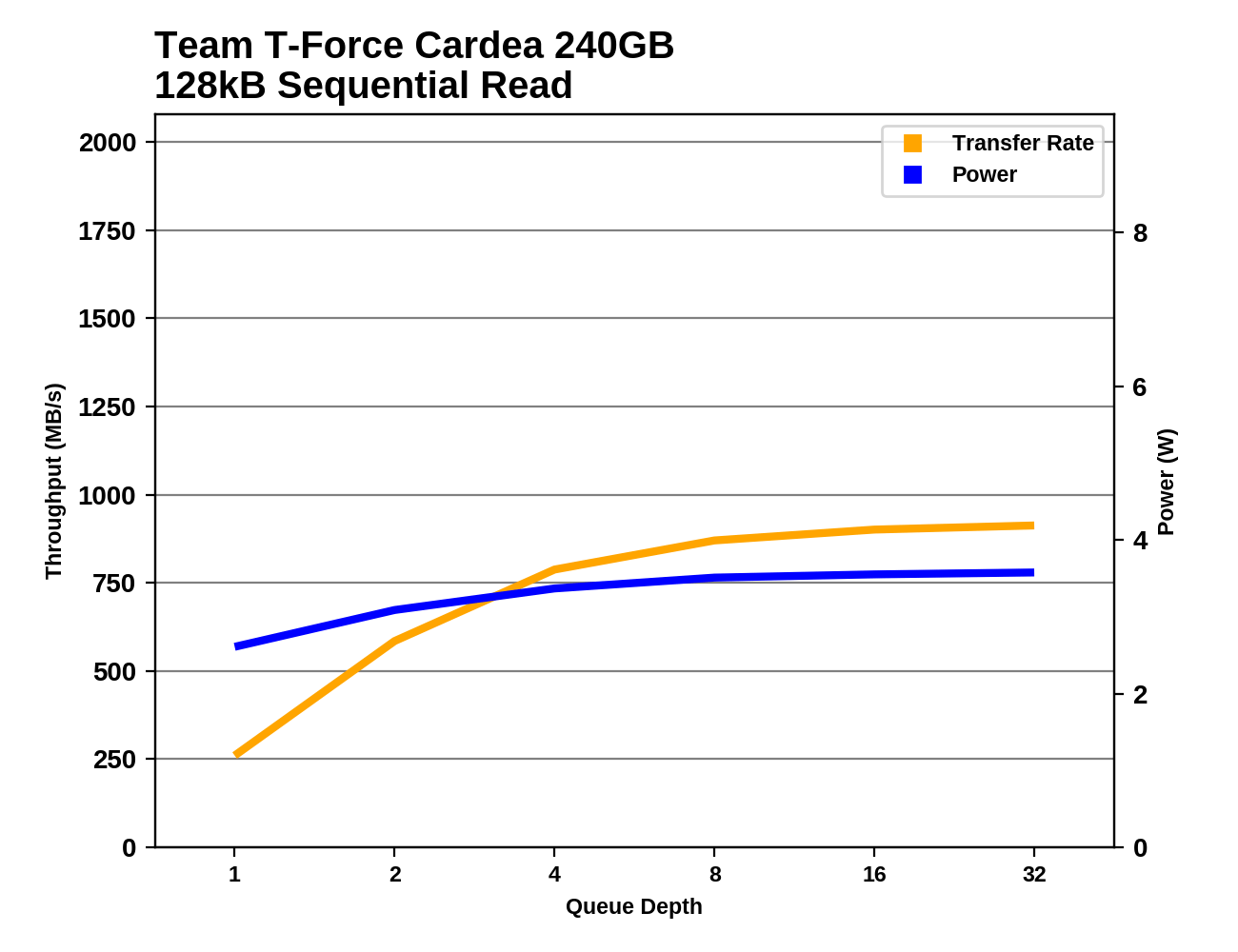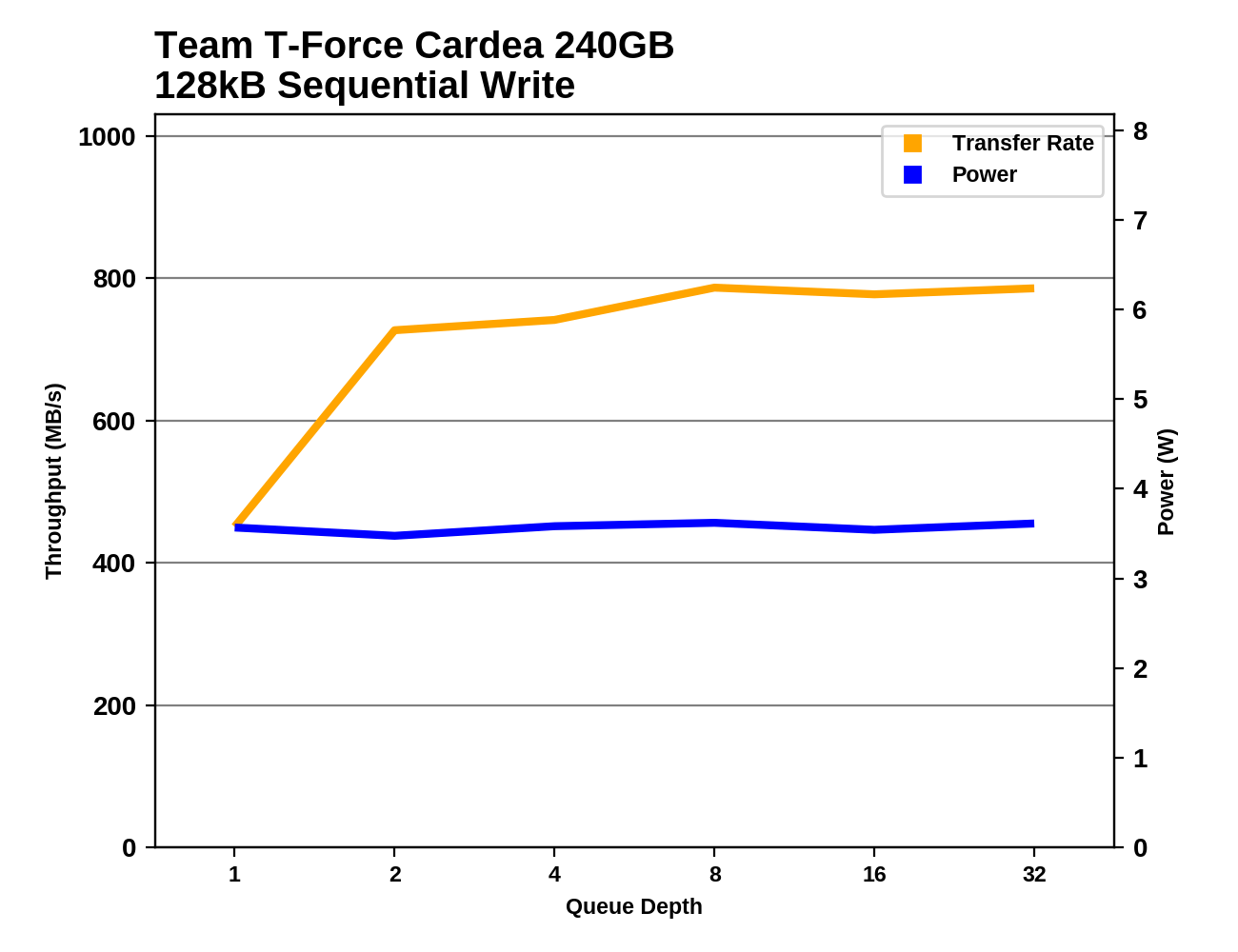The Team Group T-Force Cardea (240GB) SSD Review: Grace Under Write Pressure
by Billy Tallis on September 28, 2017 8:00 AM ESTSequential Read Performance
Our first test of sequential read performance uses short bursts of 128MB, issued as 128kB operations with no queuing. The test averages performance across eight bursts for a total of 1GB of data transferred from a drive containing 16GB of data. Between each burst the drive is given enough idle time to keep the overall duty cycle at 20%.

The burst sequential read performance of the Samsung NVMe drives is unmatched, with the 960 EVO about three times faster than the Team T-Force Cardea. It looks like Samsung's drives are quite effective at pre-fetching data in a way the other NVMe SSDs can't.
Our test of sustained sequential reads uses queue depths from 1 to 32, with the performance and power scores computed as the average of QD1, QD2 and QD4. Each queue depth is tested for up to one minute or 32GB transferred, from a drive containing 64GB of data.

The sustained sequential read performance of the Team T-Force Cardea is lower than the other (larger) Phison E7 drives and all the rest of the NVMe SSDs in this bunch, leaving the Cardea with just a 12% advantage over the fastest SATA SSD.

The power efficiency of the T-Force Cardea is also sub-par, but not by quite as large a margin. Samsung as usual is generally at the top, and the larger Phison E7 drives manage somewhat better efficiency than the T-Force Cardea die to their higher performance.
 |
|||||||||
The T-Force Cardea takes its time ramping up to full performance on our sustained sequential read test, needing a queue depth of at least 4 to get close to its maximum. That eventual limit is also well below the performance of important competitors like the Samsung 960 EVO.
Sequential Write Performance
Our test of sequential write burst performance is structured identically to the sequential read burst performance test save for the direction of the data transfer. Each burst writes 128MB as 128kB operations issued at QD1, for a total of 1GB of data written to a drive containing 16GB of data.

The burst sequential write performance of the Phison E7 drives are all quite close, and second only to the Samsung 960 EVO, albeit by a wide margin.
Our test of sustained sequential writes is structured identically to our sustained sequential read test, save for the direction of the data transfers. Queue depths range from 1 to 32 and each queue depth is tested for up to one minute or 32GB, followed by up to one minute of idle time for the drive to cool off and perform garbage collection. The test is confined to a 64GB span of the drive.

On the sustained sequential write test, the T-Force Cardea's capacity disadvantage comes into play, but it still manages to perform well and beat the Samsung 960 EVO by over 50%.

The power efficiency of the T-Force Cardea is good relative to most of its competition, though it is beat by some of the larger Phison E7 drives and by the Samsung 950 PRO.
 |
|||||||||
The main failing of the Team T-Force Cardea on the sustained sequential write test seems to be at QD1, where the larger Phison E7 drives are already operating close to their full speed. At QD2 or higher, the Cardea is only slightly slower than the other Phison E7 drives.










22 Comments
View All Comments
MajGenRelativity - Thursday, September 28, 2017 - link
Yep. Anandtech doesn't have the money to purchase a lot of their own review samples, so it is up to the company to provide them.DanNeely - Thursday, September 28, 2017 - link
More to the point, they can get enough free (donation/loan) hardware to keep their reviewers all busy; why should they buy out of pocket instead. AFAIK most exceptions fall under the category of the reviewer writing about something they bought for personal use.MajGenRelativity - Thursday, September 28, 2017 - link
That also makes senseFlunk - Thursday, September 28, 2017 - link
MyDigitalSSD is a rebrander, they slap their sticker on drives made by an OEM, quite often ADATA. I've taken a look at the model you mentioned and it looks like a PHISON E7 reference design, as such I can't really guess which OEM made it or the real model name.But if you're thinking of buying one, any review of a PHISON E7 reference design should be relevant.
willis936 - Thursday, September 28, 2017 - link
How can anyone compete against samsung in the consumer SSD space?MajGenRelativity - Thursday, September 28, 2017 - link
64 layer NAND and new controllers should allow other companies to do so. The Intel 545s puts up a stiff fightBrokenCrayons - Thursday, September 28, 2017 - link
That's easy, just sell a lower performance product at a competitive price. Certainly Samsung has some good SSDs out there, but the seat-of-the-pants feel between one of their top performing drives and a budget SSD will be small or, in some cases, not noticed outside of benchmarks since the rest of the system becomes a factor in acutal usage. These other competitors can just knock a few percent off the sales price and a lot of people will happily purchase drive that is slower.davidedney123 - Thursday, September 28, 2017 - link
Seriously, who decides "Yeah I'll trust my data to a Team Group Team T-Force Cardea, as it's tuppence cheaper than a drive from Samsung/Intel/Crucial/Some other proper company?Storage is one area I would really not recommend going for off brand tat to save a few dollars.
Billy Tallis - Thursday, September 28, 2017 - link
It's not like any of the important bits are actually designed or built by TeamGroup. This is a Phison drive wearing a Team heatsink. Phison is hardly "off-brand", though they're certainly not the premium brand. They account for a huge portion of the consumer SSD market.davidedney123 - Friday, September 29, 2017 - link
Phison sell them the controller IC, someone else makes the NAND (and the grade will depend on what they are paying the manufacturer for it), but assembly, validation, final testing, and support are all from Frangpai Magic SSD Friend or whatever they are called. My point still stands.